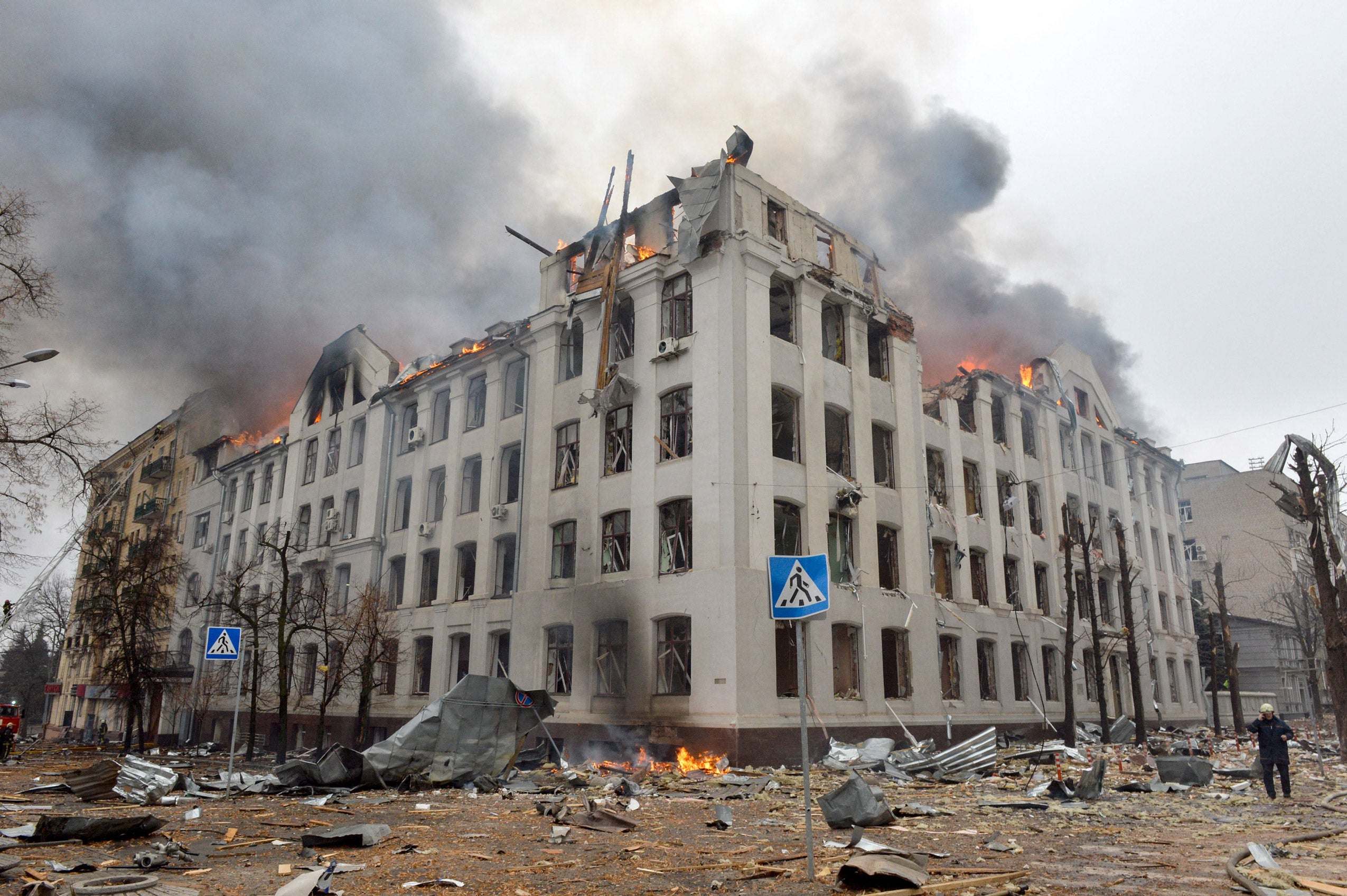As the Russian invasion of Ukraine continues to unfold, international law experts and human rights advocates have trained a close eye on the kinds of weapons being deployed in the country — and their potential to hurt or even kill civilians. Of particular concern, says Bonnie Docherty ’01, an arms expert at Harvard Law School, is the reported use of cluster munitions and other explosive weapons in highly populated areas — weapons that can be difficult to control, and which have already claimed lives.
Docherty, a lecturer on law at the International Human Rights Clinic, associate director of armed conflict and civilian protection at the Clinic, and a senior researcher at Human Rights Watch in its arms division, spoke with Harvard Law Today about two deeply troubling categories of weapons, their status under international law, and what the U.S. — and the world — should do about it.
Harvard Law Today: What do we know about the types of weapons being used in Ukraine and their legality?
Bonnie Docherty: There are two categories I want to mention: cluster munitions and explosive weapons. Just to be clear, explosive weapons as a broad category includes cluster munitions, but I want to highlight cluster munitions in particular as well.
Cluster munitions have been banned by the majority of the world under a treaty called the Convention on Cluster Munitions, which was adopted in 2008. In fact, the International Human Rights Clinic and I were part of the negotiations on that treaty [which was not signed by Russia or Ukraine]. Cluster munitions are large weapons, launched from the air or ground, which include dozens or hundreds of smaller weapons called “submunitions.” They are dangerous for two reasons. One is they spread the submunitions over a broad area, and so are indiscriminate about what they hit. And the second is that a large number of the submunitions do not explode and lay around like landmines for months, years, or even decades to come. So far, Human Rights Watch has documented the use of these weapons by Russia in multiple places, including against a hospital in the Donetska region. The Washington Post also documented, and Human Rights Watch confirmed, their use in the eastern city of Kharkiv.

The second, broader category is explosive weapons, many of which are being widely used in populated areas. These weapons include rockets, missiles, artillery shells, aircraft bombs — things like that. Explosive weapons are not banned as a category, but they are very problematic when used in populated areas, which is happening widely in this conflict. They’re even more problematic when they have what we call “wide area effects,” which means they cover a broad footprint. This is for three reasons. One is they have a large blast or fragmentation radius. Two is that they’re very inaccurate. And the third is they deliver multiple munitions at once; that could be a cluster munition, as I previously mentioned, or it could be a like a Grad multiple rocket launcher that launches many rockets at the same time.
Under existing international humanitarian law, using explosive weapons, particularly when they have these wider effects, in populated areas is often considered indiscriminate and thus unlawful because they cannot distinguish between soldiers and civilians.
It’s also worth noting that there are negotiations underway of a new, non-binding — but important — political declaration that would commit states to protect civilians from the use of explosive weapons in populated areas. States were supposed to finalize negotiations in March 2020, but the pandemic prompted them to reschedule to February 2022, a date which has once again been pushed off until sometime this spring. So, the events in Ukraine are very applicable to the current international disarmament negotiations.
HLT: What threat do cluster munitions and other explosive weapons pose to Ukrainian civilians?
Docherty: We have already seen casualties from cluster munitions. With the attack that I mentioned at the hospital in Donetska, we know that there were four killed and 10 injured. And in the attack in Kharkiv, there were 11 killed. Those are just two attacks, and I’m sure there will be others.
With cluster munitions … there’s the potential not just for immediate harm, but for long-term harm and danger to civilians – particularly kids, who sometimes think these are toys and pick them up.
Cluster munitions also leave behind many unexploded submunitions. I’ve reported on cluster missions in many conflicts — Afghanistan, Iraq, Lebanon, Georgia — and every place I’ve been, there are always a large number of failed submunitions. This means there’s the potential not just for immediate harm, but for long-term harm and danger to civilians — particularly kids, who sometimes think these are toys and pick them up. Farmers may hit them with their plows. Or in cities, they can lead to displacement or danger for people returning to their homes.
Regarding explosive weapons more broadly, obviously there is a danger to civilians lives. I don’t think anyone can pin down a number right now, but you are starting to see civilian casualties from the blasts themselves, as well as from buildings being damaged. But there are also longer term reverberating effects down the road. For example, the Human Rights Clinic did research on this issue in 2016, looking at the downstream effects of explosive weapons on health care facilities during the earlier conflict in Ukraine. Say you damage a power plant, which shuts down electricity, which then means surgeons are operating in the dark or by candlelight, which means people aren’t getting the health care they need. It’s these trickle down effects that can take years to recover from.
In other words, explosive weapons will cause not only immediate loss of life, but also damage to infrastructure, health care, education, and more. And of course, displacement is huge, and hundreds of thousands of people have already fled the country. There are going to be major, major impacts on civilians from these weapons.
HLT: What else should the U.S. or others around the world be doing to discourage the use of these weapons?
Docherty: One of the most important things countries, including the U.S., can do is to condemn the use of both cluster munitions and explosive weapons in populated areas. It’s really important to make a political statement right now. With regard to cluster munitions, there are 110 countries that have joined the Convention on Cluster Munitions, including almost all of NATO, except for the United States. The U.S. should join the treaty.
One of the most important things countries, including the U.S., can do is to condemn the use of both cluster munitions and explosive weapons in populated areas.
Further, there was a policy adopted under President George W. Bush that in 2018, the U.S. would stop using cluster munitions that had a more than 1% failure rate — meaning the rate of unexploded submunitions left behind. President Donald Trump reversed that policy. I think it’s time for President Joseph Biden to go back to the original policy and agree not to use cluster munitions.
Additionally, a lot of international law, particularly in the area of disarmament, works by stigma. And stigmas prove effective; the U.S. hasn’t used cluster munitions — except for one isolated attack — since 2003.
Along those lines, there is an obligation under the Convention on Cluster Munitions to discourage these weapons’ use, so countries who have signed on arguably have a legal obligation to condemn their use publicly. Even states that aren’t party to the convention have a moral obligation to condemn their use.
HLT: How could we assist those who have been or will be hurt in the conflict?
Docherty: Assistance is really important. The parties should ensure they keep humanitarian access open throughout the conflict. There is an obligation to allow the International Committee of the Red Cross access to POWs and to provide humanitarian aid during the conflict, for example.
Further down the road, states, as well as other organizations, should provide victim assistance. It is a general principle in disarmament law to assist individuals, families, and communities that have been harmed by problematic weapons. For example, there are obligations under the Convention on Cluster Munitions to assist those who have been harmed by those weapons. There will likely be a similar duty under the declaration on explosive weapons that I mentioned is currently being negotiated. Victim assistance encompasses not only physical and psychological care, but also measures to ensure the socioeconomic inclusion of the victim.
In addition, there will be duds left behind from unexploded submunitions, and the international community should help Ukraine take care of those.
Above all, we have to remember that even after the fighting is over, the effects of the conflict are not. There is the whole post-conflict period afterward, during which there will be a long process of rebuilding.
